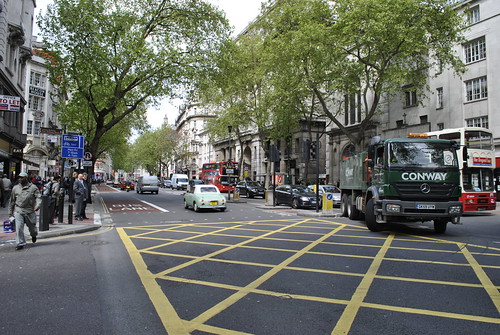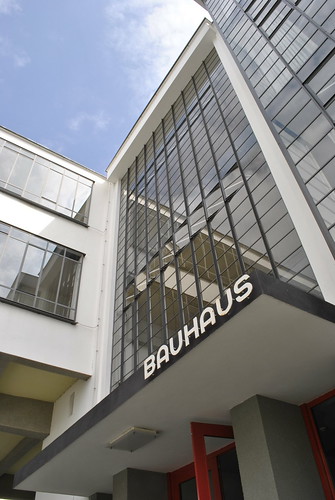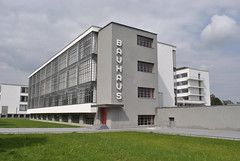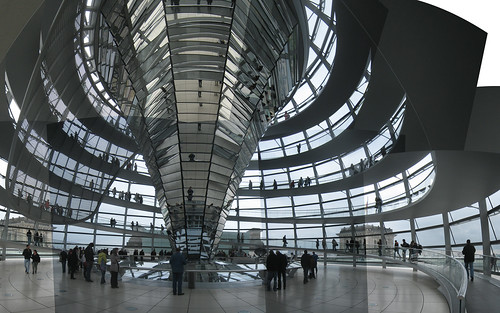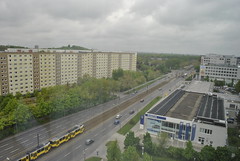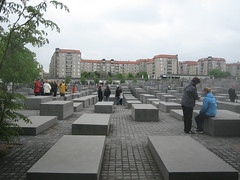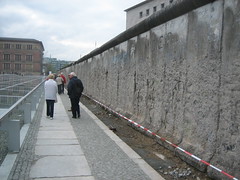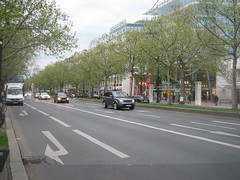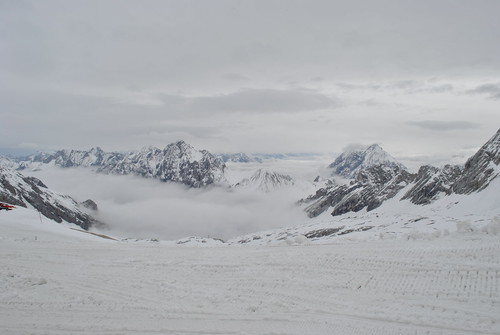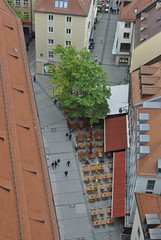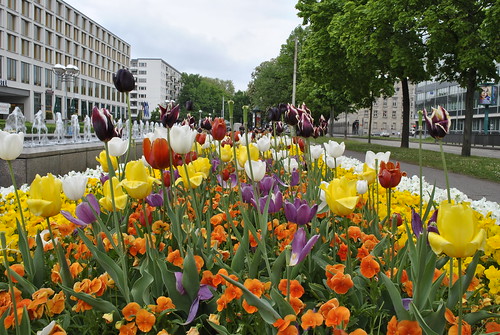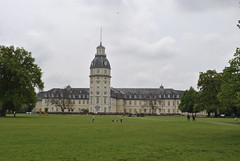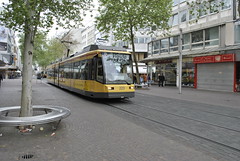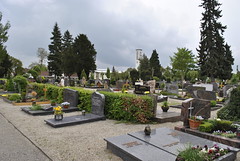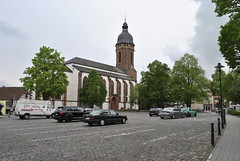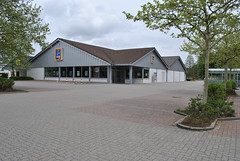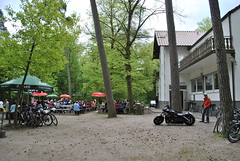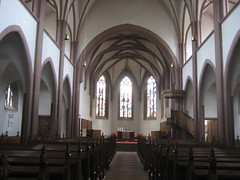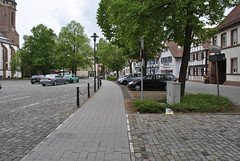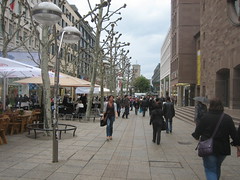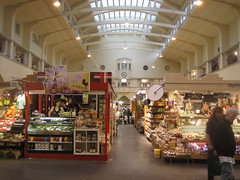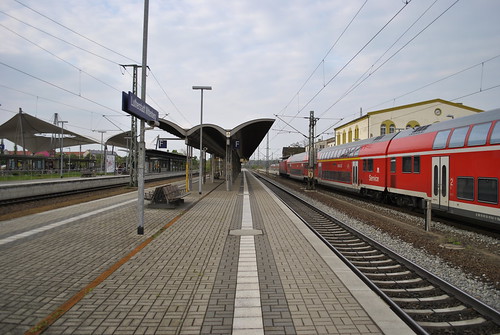This weekend marks the two year anniversary of the 2008 floods that caused destruction across the Midwest and inundated downtown Cedar Rapids and hundreds of city blocks encompassing the older neighborhoods of Time Check, Czech Village, New Bohemia, Rompot, Taylor, and parts of Oakhill-Jackson. The bulk of the event took place on Thursday, June 12 to Friday, June 13, and took out nearly every municipal, county, and federal government buildings along with thousands of individual homes and businesses.
I’m reposting my “one year later” post that I wrote last year that described my experience with the flood working at the Veterans Memorial Building on Mays Island, which was severely flooded.
The Flood – One Year Ago
One year ago today, on Wednesday, June 11, 2008, historic flooding was underway in Cedar Rapids. My third summer as a seasonal employee with the Veterans Memorial Building maintenance crew, I had a very involved, first hand perspective of the flood in downtown and public facilities. Working at the Veterans Memorial Building, better known as City Hall, which sits on Mays Island in the middle of the Cedar River in downtown Cedar Rapids, I watched the river rise daily and got regular updates and break room commentary on surrounding areas from my elder co-workers who lived outside the city. I remember watching the river rise through downtown the previous summer so up until the day or two before, it really didn’t seem like it was going to be that big of deal. Of course, official crest predictions continued to go up, and an additional downpour that Thursday pushed the river to crest at an absurd 31+ feet, breaking the old record by almost ten feet. Even during the flood and immediately after, I didn’t seem to grasp the enormity of its affect. Originally I figured we could be back in the building clearing out and cleaning up within a few weeks and have the building back up and running. Who would’ve known it’d be a year later, the lower levels cleared out and down to bare-bones, with little more than a possibility of the City offices one day returning.
Preparation at Vets Memorial
At work, the greatest day of urgency was on that Wednesday, June 11, the day before the building and much of downtown were completely overtaken with water. I recall arriving to work around 8am as normal. I walked from the GTC, where I commuted to by bus, past the riverwalk along the eastern bank of the river. The river level had began to rise above the lowest part of the walk, near 4th Avenue. Smulekoff’s, which sits directly next to the river, was clearly taking on water with a number of hoses from the basement pumping it back into the river. Water was also being pumped out of the underground Mays Island parking garage, which had begun to seep in a day or two before. This morning the river level was inches from topping the river wall lining the mid park section of the island and only four or five feet from the road beds of the three bridges.
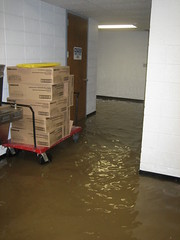 As I got into work, water had already begun to seep through the walls of the “underground” – an addition built underneath Second Avenue in the 1960s which connects the basement of the original structure to the underground parkade, also constructed at that time. Originally the location for emergency management and various other offices, the space had been condemned for a number of years due to falling pieces of concrete from the ceiling (below the street), and was essentially a large, half-demoed space used for storage, trash, and recycling sorting. Attempts to block or patch the wall seepage were no good and water quickly began flowing into the public hallway through the underground. We set up some sandbags by underground’s connection to the original building and set up a hefty pump to try to keep it down.
As I got into work, water had already begun to seep through the walls of the “underground” – an addition built underneath Second Avenue in the 1960s which connects the basement of the original structure to the underground parkade, also constructed at that time. Originally the location for emergency management and various other offices, the space had been condemned for a number of years due to falling pieces of concrete from the ceiling (below the street), and was essentially a large, half-demoed space used for storage, trash, and recycling sorting. Attempts to block or patch the wall seepage were no good and water quickly began flowing into the public hallway through the underground. We set up some sandbags by underground’s connection to the original building and set up a hefty pump to try to keep it down.
Throughout the day city office workers from upstairs were carting boxes of city legal records and other documents stored in the basement up to the auditorium on the first floor – which of course, turned out to be in harm’s way anyway as the final crest was two feet above the first floor.
I took two or three trips to Public Works in the dump truck to pick up pallets of sandbags that day. Volunteers were working around the clock filling sandbags for city and private use. I had trouble even getting in with the line of cars waiting to get their ten alloted sandbags. City vehicles were able to drive in to be loaded with full pallets. While in line one a woman was handing out free pizza and told us to “Keep up the good work.” As the situation worsened, cooperation and morale ran high.
Returning to the building with my first load, just about noon, I encountered heavy traffic. Congestion around public works and downtown as people rushed to prepare homes and businesses, along with the closure of the 3rd Avenue bridge made a normal five minute trip, take more like 20 or 30 minutes. It had begun raining at that point, making the enduring flooding seem even more dire. When I finally made it to the First Avenue bridge, I pulled into the east alley by the building and started unloading the sandbags around a basement window opening before breaking for a quick lunch in the shop.
Rain clouds cleared in the afternoon as work continued. Lots of people were downtown – many came as onlookers, and many came to help. Two guys who were walking by helped us unload another truck load of sandbags in front of a west side entrance to the mezzanine level. Back to public works for another load – surface level flooding becoming much more apparent in low areas a few blocks from the river. On my last trip back to Mays Island, police were diverting westbound First Avenue around 6th Street West due to water now over the road (in lower areas, not all the way from the river). I was allowed to go through as I was just going to City Hall.
Towards the end of my work day I helped the two night guys move supplies from the basement up to the dining room on the mezzanine level – again a futile effort as this room was entirely submerged the next day. Before leaving the building around 5pm, I went to the roof to get some pictures of the river flooding from all angles. At this point the 3rd Avenue bridge had been closed as water was but a foot from the road bed now. 2nd Avenue bridge was closed about an hour later. Eventually all river crossings in the city were closed except for I-380.
The Crest
The next morning, Thursday, June 12, it was raining hard. I had planned to go into work early but the building and much of downtown had already been completely inundated. That day, at home, we had to deal with rain-related water coming into our basement. My brother Daniel was also hurrying to move guitars and equipment from his recording studio about seven blocks from the river – just in case. He and his business partner had just signed a lease for a larger, more permanent space in downtown Marion so they simply moved much of it to their new location. I went along to help them out in the afternoon as rain was still coming down – and the river still rising.
After finishing up we decided to walk a few blocks toward the river where the water had now reached past the 4th Street railroad tracks in the downtown core. Many National Guard officers were on the scene keeping the public away and out of the water as volunteers continued sandbagging buildings close by. We didn’t stick around very long.
The next few days were to watch and wait. Many businesses outside of downtown were closed as accessibility throughout the city was extremely hampered with 380 being the only river crossing for days. With three of the city’s four collector wells being flooded, conserving water was also critically important. Most businesses and residents obeyed mandatory water restrictions, refraining from doing laundry and showering for days. The Cedar River finally crested at around 31 feet early afternoon on Friday, June 13, taking thousands homes and hundreds of city blocks.
Pretty much confined to the house as my summer job was under water and most businesses remained closed, that Sunday was a less than average Fathers Day, I imagine, for most of the community’s dads. My brothers and I went to see our dad that afternoon out at Kirkwood, where he had spent the past few days reporting news on the flood at KCCK radio. This was my first time crossing the river since the floodwaters had submerged much of downtown, and certainly Mays Island. Though water had already recessed a number of feet, the view from 380 was no doubt dramatic.
Post Flood Clean Up
I finally returned to work the following week on Tuesday, the 17th, meeting my VMC co-workers at the Police Station to start picking up sandbags and debris, along with some guys from the city parking division. As transit serve had not resumed yet, my mom gave me a ride there. After passing a checkpoint many blocks from the station, we drove down blocks of empty streets surrounded by empty houses and no people. It was very surreal.
All downtown bridges were reopened and transit service resumed Wednesday, the 18th, with limited service so I took the bus to work. A temporary transfer site was set up at 4th Ave and 12th Street SE, and buses were not allowed to pick up or drop off any passengers inside the still access-controlled flood zone. Since I was to report back to the police station, they allowed me off with a show of my city badge. With the same crew from the day before, we finished picking up sandbags at the station and then headed across the river to pick up bags at the public library. Private clean up crews were already well underway at the Great America Building across the street and downtown was beginning to buzz as debris piles began filling the curbs.
A few days later my first return to the building was to help take photos of damage. We entered through a side door to the mezzanine off the loading dock ramp. Our view as we entered can be seen in the photo below. Everything inside was covered in mud, plaster and paint falling off the walls, and an unrecognizable darkness. Water still had not receded out of the basement so the mezz was as far down as we could go. Up on the first floor, which had taken on about two feet of water, the old wood auditorium floor was completely ruined as were many artifacts in the Spanish American War Memorial room that served as the VMC office.
Over the next few days as water went down to a foot or two in the basement, we recovered the gas pump we had been using the previous and set it up to pump out the remaining standing water. We now had a couple state troopers for 24/7 security, as we took turns “watching the building” – essentially just refueling the pump whenever it ran out. I spent many long days just sitting by the First Avenue doors watching the cars go by.
Not surprisingly, it took at least a week or two for professional cleanup crews to start picking up Vets Memorial, while many other buildings were already underway. Although I was not in position to actually do any cleanup work, they did need someone from our department there at all times as a go-to person and to unlock and lock the building at the beginning and end of the day. Like watching the pump, many afternoons, evenings, and Saturdays were spent simply sitting around at the building. I got to know our regular Per-Mar security gang, which replaced the state troopers as security. Other than that, the night crew and I spent much of the rest of the summer out at Veterans Memorial Park, by the stadium, which is also owned by the Vets Commission.
After returning to Ames this past year for school, I tried to keep up with recovery news from the Gazette and other sites, but it was hard not to disconnect from the flood. With the few days I was back in town for Thanksgiving and Christmas it was hard to gauge the progress. At spring break time in March, downtown had been pretty well cleaned up and many major businesses had returned. But work continues for smaller businesses and other less visible areas, like New Bohemia, Czech Village and Time Check.
